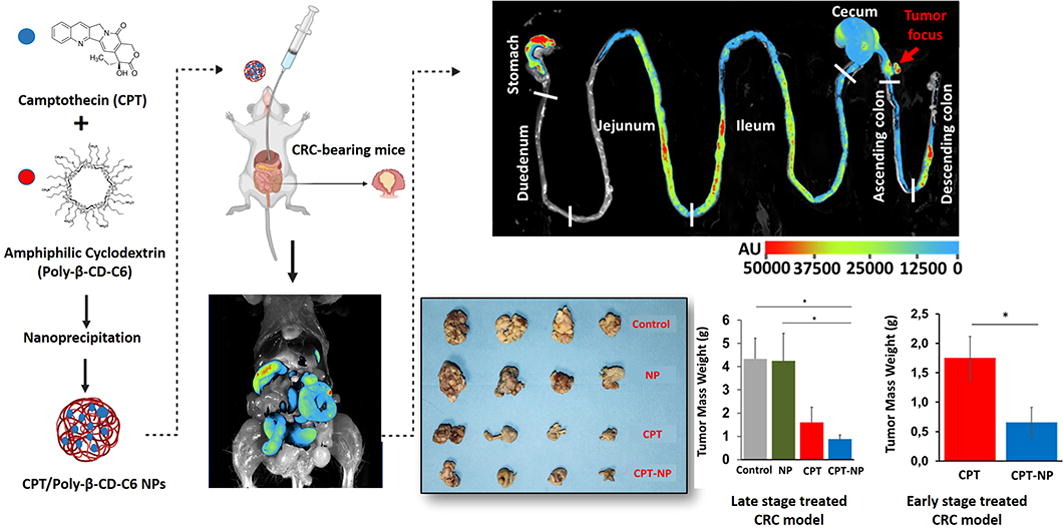Therapeutic efficacy and gastrointestinal biodistribution of polycationic nanoparticles for oral camptothecin delivery in early and late-stage colorectal tumor-bearing animal model

Colorectal cancer (CRC) is the third most commonly diagnosed cancer in the world and is the second leading cause of cancer related deaths. New cases are increasingly diagnosed every day, but current therapeutic options are still insufficient for an effective treatment. In CRC treatment, there is a significant need for alternative treatment approaches that can both prevent relapse and provide strong antimetastatic effects as the intestines and colon are prone to metastasis to neighboring organs and tissues as well as the liver and the lung.
Highlights
Camptothecin can be delivered to colon tumor via oral nanoparticles.
Nanoparticulate camptothecin is more effective in reduction of tumor size and number of metastatic foci.
Improved therapeutic efficacy of camptothecin encapsulated in polycationic cyclodextrin nanoparticles is more pronounced in early stage tumors.
Biodistribution of oral fluorescent nanoparticles were different than fluorescent solution; tendency to accumulate at tumor and noteworthy retention at stomach wall.
Localized colorectal tumor induction technique demonstrated with early and late stages.
Positively charged oral cyclodextrin nanoparticles are promising for gastrointestinal cancers.
In this study, optimized polycationic cyclodextrin (CD) nanoparticles for oral Camptothecin (CPT) delivery were comprehensively examined for in vivo performance in early and late stage tumor bearing mouse model in terms of antitumoral and antimetastatic efficacy of CPT bound to polycationic CD nanoparticles in comparison to free CPT. In addition, the gastrointestinal localization of a single administration of fluorescent dye loaded polycationic CD nanoparticles in the gastrointestinal tract at the end of 24 hours after oral administration was also imaged and evaluated by in vivo imaging system against fluorescent dye intensity. Results showed that survival percentage was significantly improved in CRC-bearing mice compared to oral CPT solution, with significantly reduced colorectal tumor masses and number of liver metastatic foci (p<0.05).
It was also possible to differentiate between the effectiveness of nanoparticles in early or late stages of CRC. In vivo imaging studies have also confirmed that polycationic CD nanoparticles are able to deliver the therapeutic load up to the colon and tend to accumulate especially in tumor foci, indicating an effective local treatment strategy. In addition number of liver metastases were significantly decreased with the CPT-loaded polycationic CD nanoparticle formulation in both early and late stage tumor models. These findings indicated that CPT-loaded polycationic CD nanoparticles could be an efficient oral nanocarrier formulation for anticancer molecules that have limited application because of oral bioavailability and stability problems.
Article information: Sedat Ünal, Süleyman Can Öztürk, Elif Bilgiç, Hamdullah Yanık, Petek Korkusuz, Yeşim Aktaş, Juan M. Benito, Güneş Esendağlı, Erem Bilensoy, Therapeutic efficacy and gastrointestinal biodistribution of polycationic nanoparticles for oral camptothecin delivery in early and late-stage colorectal tumor-bearing animal model, European Journal of Pharmaceutics and Biopharmaceutics, 2021. https://doi.org/10.1016/j.ejpb.2021.10.010.

